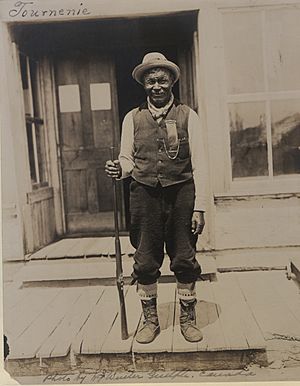Ignace Tonené facts for kids
Quick facts for kids
Ignace Tonené
|
|
|---|---|
| Maiagizi | |

Tonené in 1909
|
|
| Born | 1840 or 1841 Near Lake Temagami
|
| Died | 1916 |
| Nationality | Temagami First Nation |
| Employer | Hudson's Bay Company |
| Known for | Teme-Augama Anishnabai leadership |
Ignace Tonené (born 1840 or 1841 – died 1916) was an important leader of the Teme-Augama Anishnabai community. He was also known as Nias and Maiagizis. He worked for the Hudson's Bay Company, traded furs, and even searched for gold.
Tonené started as a deputy chief, then became the main chief, and later a "life chief" (meaning he was a chief for his whole life). He worked hard to get yearly money and land for his people from the government. But the leader of Ontario at the time, Oliver Mowat, stopped his plans for land.
Tonené's search for gold caused a big rush in 1906. He found the gold that led to the Kerr Addison gold mine. Sadly, his discovery was taken from him by European settlers.
Contents
Early Life
Ignace Tonené was born in 1840 or 1841. His birthplace was near Lake Temagami. This area was home to the Teme-Augama Anishnabai community, part of the Temagami First Nation. At that time, British settlers called the area Upper Canada. He was the oldest son of François Kabimigwune and Marian.
Career and Community Leadership
Tonené worked for the Hudson's Bay Company. His job was to deliver mail between their trading posts. These posts were located at Lake Timiskaming and Lake Temagami. He also worked at Fort Témiscamingue. There, he probably learned to speak French.
Leading the Temagami Community
Around 1868, Tonené was chosen to be the anike ogima. This means "deputy-chief" in English. He took over this role from his father. In 1878, he became the main chief.
As deputy-chief, Tonené brought up an important issue. His community was not included in the Robinson Treaties of 1850. These treaties were agreements between European settlers and Ojibwe nations. Tonené and two others met with Charles Skene, a government official. They explained their worries about lumberjacks coming onto their land. They wanted a yearly payment, called an annuity, and a special land area, called a reserve. This was because their people's land had not been given up to the Canadian government.
On January 1, 1879, Tonené gave a speech. He warned his community that "the white men were coming closer and closer every year." He also said that "the deer and furs were becoming scarcer and scarcer." He worried that in a few years, Indigenous people could not live by hunting alone.
He kept pushing for government money and a reserve. He held meetings and wrote letters. These letters were in both English and the Anishinaabe language. In 1880, Lawrence Vankoughnet agreed that about 2,700 square miles of Temagami land was indeed unceded. This meant the land had not been given up.
The Canadian Prime Minister, John A. Macdonald, passed the issue to the Ontario Premier. Land claims were a provincial matter, not federal. However, in 1883, the Department of Indian Affairs agreed to yearly payments. These payments were similar to what other First Nations in the Robinson-Huron Treaty received.
In 1884, Tonené called a tribal council. They met on Bear Island. They discussed where the reserve should be. Tonené suggested about 100 square miles around Cross Lake and the south end of Lake Temagami. The community agreed to this plan. The federal government also agreed. But the Ontario premier, Oliver Mowat, stopped the land transfer. Mowat was known to be against Indigenous treaty rights.
In 1888, after Mowat's refusal, Tonené moved his family. They went to land between Lake Opasatica and Lake Dasserat. This area was near Abitibi, in Quebec. In 1889, he traveled back to Bear Island. He asked the Indian agent for farming supplies for his community. During his journey, Tonené hunted and trapped to feed his family. He also started prospecting (searching for valuable minerals). This was because silver had been found at Cobalt, Ontario.
Tonené became very good at prospecting. The Canadian Mining Journal said he started the Larder Lake gold rush in 1906. He found the gold deposit that later became the Kerr Addison gold mine in McGarry. However, his discovery was taken from him. Laws at the time made it hard for him to get his claim back.
John Paul became the head chief after Tonené. But Tonené continued to hunt and trap in Abitibi country. When John Paul died in 1893, Tonené became the head chief again. From 1910, he was an honorary or "life chief." He was the main advisor to the new head chief, his younger brother Frank White Bear.
Family Life
In the 1870s, Tonené married Angèle. She was the daughter of Nebenegwune, a former Temagami band chief. They had two sons and two daughters. Angèle died in 1869 while giving birth to their youngest child. In 1871, Tonené married Elisabeth Pikossekat from the Timiskaming band. They had three daughters together.
All of Tonené's sons died before they became adults. However, his five daughters all lived to be adults, got married, and had children.
Death and Legacy
Ignace Tonené passed away in 1916. He was buried near Mount Kanasuta, close to the Quebec-Ontario border. The place where he was buried later became a gravel pit and then a community dump.
Today, the lake south of Bear Lake is named Chief Tonené Lake in his honor.

